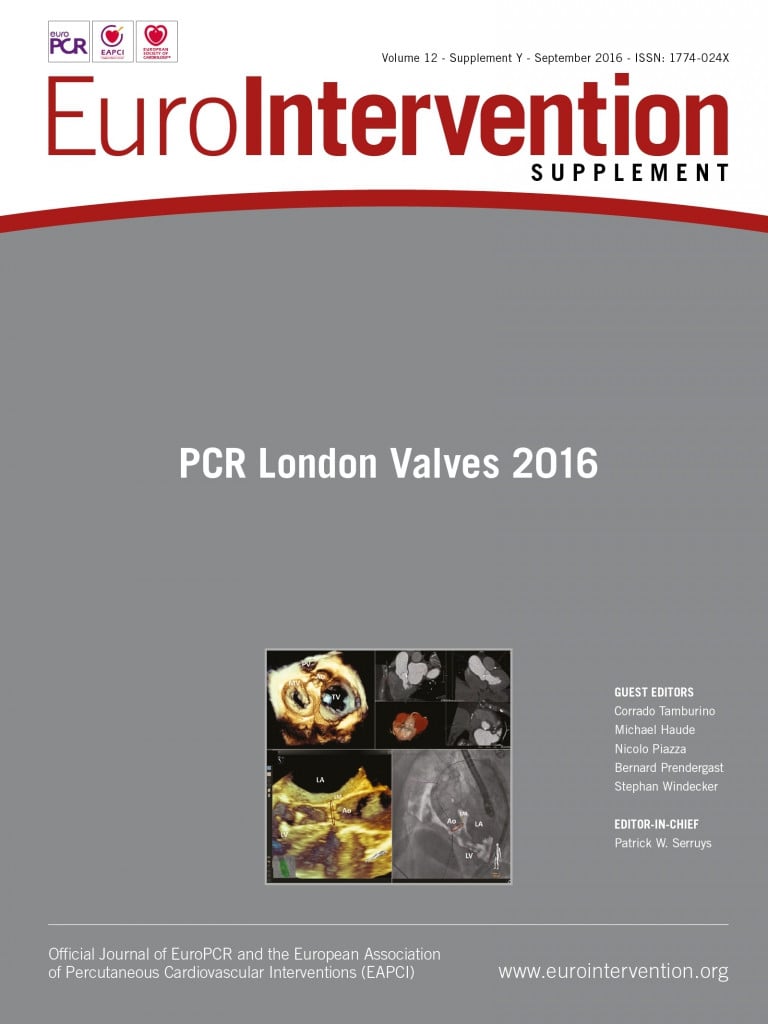Interventional cardiology is a culture endowed with innovation. Within the last 40 years, since the first percutaneous coronary intervention, the field has travelled through the panorama of bare metal stents, drug-eluting stents, bioresorbable scaffolds, percutaneous left ventricular assist devices, percutaneous shunt closure, left atrial appendage occlusion devices, transcatheter aortic valve implantation (TAVI) and, more recently, transcatheter mitral and tricuspid valve interventions. As expected, first-in-human experiences with these devices were associated with suboptimal device platforms, patient selection criteria, procedural techniques and clinical outcomes. Nonetheless, interventional cardiologists have been able to learn and adapt from their initial experiences with dramatic improvement in clinical outcomes over time: this cycle has typically spanned 10 years of reiterations in patient selection, procedural techniques and device designs.
Transcatheter mitral valve replacement can be considered a “close cousin” to TAVI. Initial first-in-human experiences with TAVI were associated with 30-day mortality rates as high as 50-80%, major adverse cardiovascular event rates in excess of 50%, procedural duration ≥5 hours, need for cardiopulmonary bypass, transfemoral delivery catheter profiles ≥25 Fr, hospital length of stay ≥10 days, inadequate imaging protocols, and poor patient selection criteria leading to the treatment of futile patients with inevitably poor outcomes. Contemporary TAVI results consist of 30-day mortality rates ranging from 0-5%, procedural duration 30-60 minutes, delivery catheter profiles as low as 14 Fr, multislice computed tomography-based patient and device selection, and hospital length of stay between one and five days. Thoughtful and rigorous clinical trial execution has also allowed the expansion of TAVI from extreme to intermediate surgical risk patients owing to superior results; low-risk patients are currently undergoing investigation.
In addition to the physician learning curve, several large industry partners have now accrued substantial knowledge in the techniques of transcatheter heart valve development, specifically material selection and processing. Furthermore, dedication to physician training and proctoring programmes has contributed to the credibility and solid foundation for best practice patterns.
Physicians and industry are leveraging the substantial TAVI knowledge towards the field of transcatheter mitral valve interventions. Nonetheless, the field of transcatheter mitral valve replacement appears to be progressing slower than TAVI once did, with significant challenges existing in patient referral patterns and anatomical selection criteria. Referring physicians need to be better informed about transcatheter treatment options and patient selection criteria. Similarly, physicians performing these procedures need to understand better the pathophysiological disease mechanism and multimodality imaging of the mitral valve and to define inclusion/exclusion criteria better.
Initial results with several transcatheter mitral repair and replacement devices have been encouraging. Currently available CE-marked repair devices include the MitraClip® (Abbott Vascular, Santa Clara, CA, USA), Carillon® (Cardiac Dimensions, Kirkland, WA, USA), NeoChord (NeoChord, Inc., St. Louis Park, MN, USA), Mitralign (Mitralign, Inc., Tewksbury, MA, USA), and the Cardioband® (Valtech Cardio, Or Yehuda, Israel). Aside from the MitraClip with more than 35,000 procedures performed worldwide, the remaining devices have been implanted in just a few hundred patients. Repair devices are associated with low 30-day morbidity (<10%) and mortality (<5%) rates in relatively high surgical risk patient populations. Residual mitral regurgitation (MR), however, can be viewed as a potential concern; 0-1+ MR is achieved in 20-60%, and 2+ or less in 45-90% of patients with secondary mitral regurgitation.
On the other hand, the results achieved with transcatheter mitral valve replacement have been variable but not discouraging. In total, approximately 100 procedures have been performed worldwide. Patient selection has proven to be extremely challenging, especially the assessment of left ventricular function and its recovery post valve replacement. Anatomical screening with multislice computed tomography to mitigate the risks of valve embolisation, paravalvular leak, and left ventricular outflow tract obstruction has led to significant exclusion rates from clinical trials. Short-term mortality rates have ranged from 0-40%, and residual mitral regurgitation of 0-1+ is achieved in virtually 100% of patients.
Similar to past innovations in interventional cardiology, transcatheter mitral valve interventions will begin their quest in Waterloo and will make their way towards Eldorado with great enthusiasm, passion and perseverance.
Conflict of interest statement
N. Piazza is a consultant/proctor with equity shares for Highlife, consultant/proctor for Medtronic, consultant for Boston Scientific, consultant for Direct Flow Medical, and consultant for 4Tech. S. Windecker’s institution has research contracts with Abbott, Biotronik, Boston Scientific, Edwards Lifesciences, Guerbet, Johnson and Johnson, Medtronic, Merck Sharp and Dohme, Novartis, Sorin, St. Jude, Symetis and The Medicines Company.

